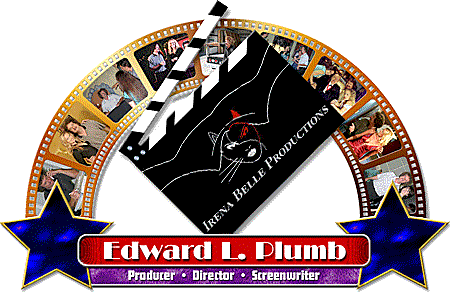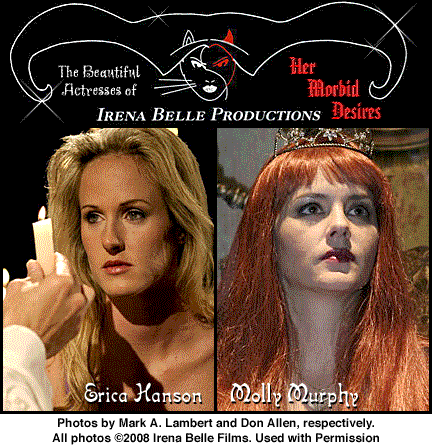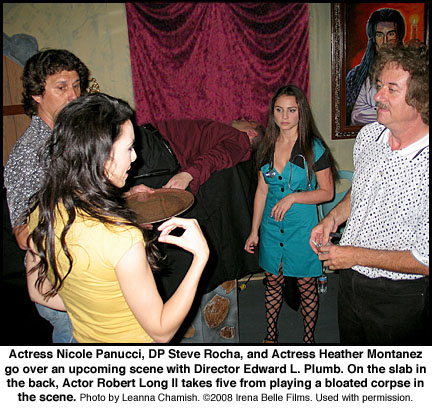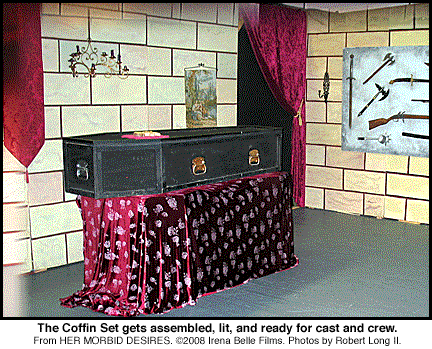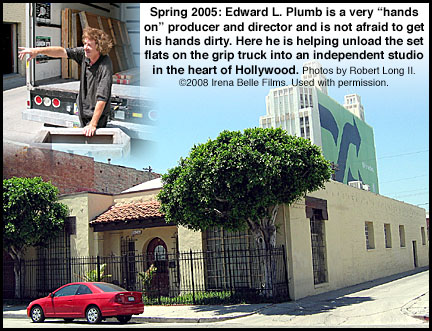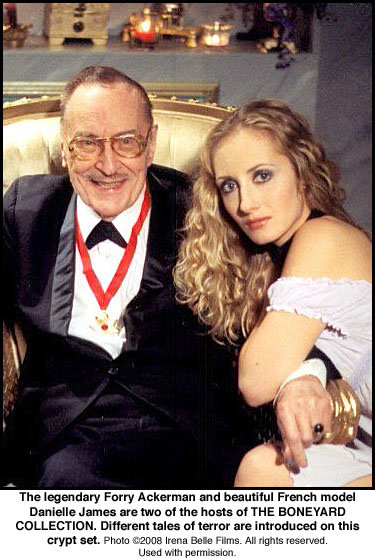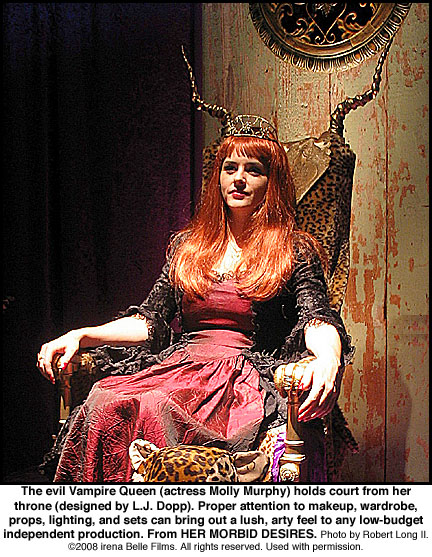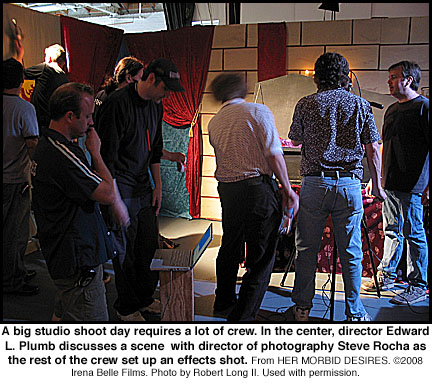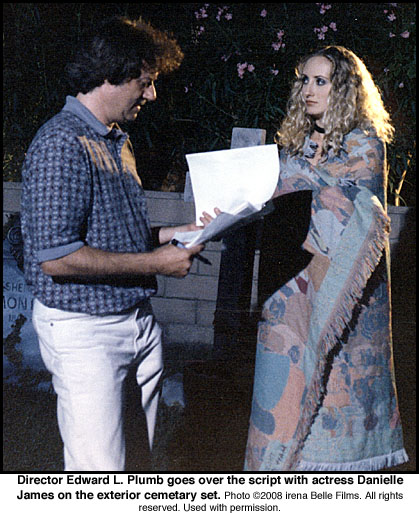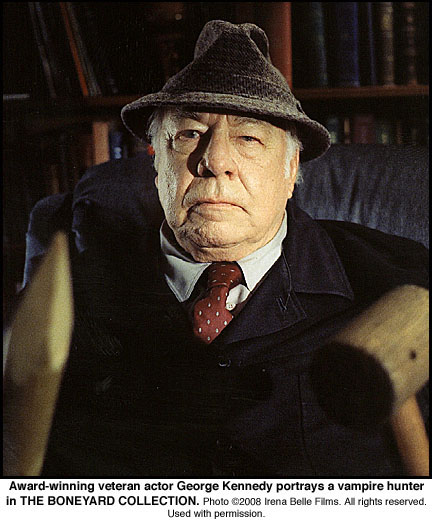Search
West Coast Producer/Director/Screenwriter Edward L. Plumb gives Smash or Trash an In-Depth Interview on the Inner Workings of an Independent Hollywood Production – Part One
Interview ©2005-2008 by Robert Long II
Robert: Edward, you have worked with both film and video: which do you prefer to work with, and why? What are the pros and cons of both mediums?
Edward: When it comes to a preference with working in film or video, as a self funding producer, I must say that I will always go with video. That way, I can spend less money in post, and get more for my dollar in making the movie. Not worrying about film development, processing, negative cutting, test prints, and all the other requirements needed to work with film in post, leaves me with less financial burden than when I work with video. I’d rather have more money to spend on talent and the art department, because my movies completely rely on the overall look of what’s on the screen. I spend a good deal of money on building sets, dressing the sets, and hiring beautiful actresses in striking costumes, to make it all work as “eye candy.” I also try to get name talent to make an appearance in my projects.
When it comes to making my type of movie, we try to be artists with beautiful lighting , beautiful sets, and gorgeous actresses. We treat our productions like art. The artist in this case is a group effort of DP/gaffer, production designer, scenic painter, costuming, makeup and hair departments, etc. The artist makes the difference, not the medium. Here it doesn’t really matter whether it’s video or film, if it looks fantastic. It’s not the canvas, nor the paintbrush, it’s the artist himself.
Sure, if you have someone else funding your film, and there is enough cash to pay for talent, crew, art production, and all the perks that go with it, then go with film. That’s just not the case when it comes to what I’m doing as a low budget, independent film maker trying (and succeeding) at making arty-looking movies.
Robert: I know this from working on your productions, but would like to hear it in your own words; what kind of affordable film or video camera would you recommend to those in the independent film business?
Edward: I recommend the Canon XLI, which is what we use when we shoot our films. This is not my department, so I’m not that familiar with the features. I know they use filters to get a special artistic look. We usually use 2 cameras and they’re the same make and model so that their footage matches in the editing.
Robert: What about the kind of lighting equipment you use? What do you feel is essential as a basic kit for someone starting out in this business?
Edward: I’m not that familiar with lighting kits, but I do know we use baby spots, 1K’s, 2K’s, and 5 K’s. When we have to light up a graveyard or a castle we flood the large sets with 4 or 5 lights on 10 to 12 foot high light stands.
We spend a minimum of an hour to 1 1⁄2 hour lighting a scene. When we can, and that’s most the time, we spend a full prep night pre-lighting a set. We block out all our scenes, so we know where and when we have to change the lighting on the day of the shoot. I have a GREAT gaffer/DP named STEVE ROCHA (“Red Shoe Diaries”, “Red Rock West”), who sees eye to eye with me on the look of the film. We make things look very arty, very film noir, even though we are shooting in the horror genre. Again, everything has to look beautiful to the eye. Every actress must look beautiful on the set. The right kind of lighting makes all the difference in the world.
Robert: You have worked with partners in the past. What are pros and cons to this collaborative effort? What compromises have to be met to have a good creative team up?
Edward: I do a handful of movies every year, working with new partners, whether they be writers, directors, or producers, on their own projects. I have one partner , Shawna Baca, that writes, produces, sometimes stars and sometimes directs her own projects. I come aboard her films as a producer, and it is my job to help her get the film “in the can”. Then, she finishes the film on her own, or if she is so inclined, will ask my opinion on something, but basically, it is her baby and she knows how to handle post production. Shawna has gotten her films into many film festivals, including THE SLAMDANCE FESTIVAL. And, this is how I work on most other people’s projects, too. When you get involved, it is best to know what is expected from you from the onset. That’s the good side of film making.
Here is an example of the nightmare of film making. I wrote a vampire film once where we went through two directors, and I ended up doing most of the directing chores as a second unit director. For instance, one director never did a close-up shot of any actor in the film, and I had to shoot numerous pick ups to make up for this fault. Then I had disputes with the other producers on how the film should be edited. Needless to say, you must establish before production begins who has FINAL CUT on the movie. At one point there was going to have to be two separate edits of the same film: one edit by one set of producers using their editor, and the other edit by myself, as the “writer-producer cut” using an editor of my choosing. Fortunately, somehow, we ironed things out and worked together to make the final cut of the film work. I also learned that if I want the film to be done right, it is best to direct it yourself, especially when you know more than the director that you’ve hired.
For my own films, which means the ones that I write, direct, and produce, it is best to find a team that works t0gether well, and keep using them. I use the same DP/gaffer, production designer, second camera, makeup and hair people, sound mixer, editors, assistant directors, still photographers, even lead actresses, on all my films. Of course, you have to make a few films to find this consistent crew, but it sure is rewarding, as they learn how to make everything run smoothly together. You learn about each other’s temperaments and what to expect every time you show up for a shoot. And a good rule always is to have a real good backup for these positions, in case someone is booked for another job and unavailable for your shoot day/s. Reliability is crucial when making films, regardless of the budget.
Robert: Edward, what kind of pre-planning do you do for an upcoming film? Do you storyboard? Do you hold script meetings to get feedback on what will and will not work?
Edward: Pre-planning is very important for my style of film making. After I’ve rewritten and rewritten the script numerous times, then I’m finished and I give it to the DP for him to check out.
He gives me his feedback and we go over the whole script, making sure it’s going to work. Then, I choose my lead character for the film. My lead characters are always women, and I give the script to my lead actress/es to see if it is something that they really would LOVE to be in and can commit to for a year of their life. Since, I only film once a month, and they know what that entails. Their look must basically remain the same during this time period. The DP and I meet weekly making sure everything’s on track.
We take 30 days to prep for each shoot date. Also, during this first month or two, I go through my list or stable of actresses to see if they like the parts I’ve chosen for them. No one yet has turned down a role that I’ve given to them. About every 4 months I put an ad in the trades to audition new starlets, because once one of my regular actresses joins SAG, I look for a replacement. I always have a SAG contract and I only use “name” SAG actors. I can’t afford $830 for unknown SAG actors to be in my movie. It is better for me to get another pretty up and-coming actress to do the role.
The first week I figure out the scenes to be shot each month, and then the production designer (L.J. DOPP) draws the set, and he and the carpenter starts building the sets. During this time, I go over costumes with the actresses for the scenes. I have a closet full of sexy witch and vampire costumes, many different capes, assorted colored and styled wigs, druid cloaks, and goth costumes. The actresses and I choose from the closet, or they bring something sexy from home, or we go shopping at a mall to see what will work. Sometimes these garments are dyed. I have to pick a date a full month ahead to make sure the whole film crew is available that night. We make digital comedy/horror films and pretty much shoot only at night. It usually takes two weeks to get this all in place.
In the third week, the production designer and I figure out how to dress the set and what colors are best to make it all work. The actresses practice their lines and may take time to get their costumes altered.
The fourth week is showdown. On Monday, the DP, sometimes the production designer, and I go over the blocking the set. Tuesday, the talent comes for a rehearsal and we make sure the blocking works. At the end of the week we pre-light the set.
Shoot night happens. Each actress is in makeup for at least 45 minutes and hair can be an hour to an hour 1⁄2 . If it’s a night of zombies, then it’s over an hour for each zombie in makeup with 3 makeup artists at work and if it’s a mummy, we’re talking 3 hours in makeup for him alone. Every thing on this page is our regular monthly schedule for making a movie. And, then when you see the result, it’s always worth it.
Robert: Are your films self-financed, or do you have investors? If you have investors, what is your advice on how to obtain them?
Edward: I self-finance my own films, and in that way I do have complete control. I did co-finance a film and found that we had disagreements in post production. If I were to get financing or co-financing from someone, we would have to work out things like “final cut”. If this is worked out ahead of time, I would love to get outside financing. Show me some investors willing to put money behind my style of film, which is arty looking movies with light comedy in a horror setting, and I’d love to have them come aboard. Heck, I ‘d be willing to do serious horror, long as it remains arty-looking, Sign them up, I’m ready to hear from them any time.
When I produce other people’s movies, they get the financing from relatives or friends. Some even put their house up for collateral to get money to make their film, but that can get pretty risky.
Robert: What, of all your projects, has had the largest budget? Which has had the smallest budget? Can you give me examples of where the money goes on a project? Can you give me cost reasons of why one film is more expensive than the other?
Edward: I can’t conceive of making any of my films for less than $1200 a minute. By the time I’m done, including going all the way through post, I’m lucky if it’s around $1500 a minute. And, one that I did recently was over $2000 a minute. At that rate, an 80 minute movie will cost me one hundred sixty thousand dollars. And, my films are digital, using SAG actors, and “names” that will gain attention of some sort. This is the way I make my own films. And, “names” and style are what’s important for me to get a distributor. Also, I call in a lot of “favors” in getting friends to help me make the movie. This would include getting free locations, getting “name” actor friends to do an appearance, musician friends to do the music, and getting friends to really “work” with me crew wise.
When I work on other people’s movies, they don’t always get “name” actors or SAG actors, so, their budget is a lot less. They’re more concerned with getting their vision on film and use their movie as a calling card to the film industry and get their product out to film festivals. This way they expect to get attention for their next film. Distribution is not at the forefront of what they’re doing. Also, they mostly do short films.
Robert: Edward, is there a script-writing or script-formating software out that you recommend using?
Edward: I’ve been using MOVIE MAGIC as my software for script writing for over a dozen years. I like the formatting and it’s easy to use. I just sit down and type and I don’t need the script-ware to do anything special for me.
Robert: Who comes up with the story and the script? Is it a collaborative effort? Do you allow outside contributors to submit a story outline or synopsis?
Edward: When it comes to writing scripts I mostly work solo, but I have done collaborations and once I even bought a short story from a friend and wrote the screenplay based on his work. But, I usually come up with all the script ideas on my own. In fact, when I was working on this published story, I ended up using only his ending and created the rest of the ideas to make it all work. His story HER MORBID DESIRES is about a serial killer killing actresses on many low budget films, and I changed it to the killer being on one big budget vampire movie.
I found working with others does work okay if you’re writing a comedy and someone works with you to throw in jokes. I‘ve done a few anthologies where I had a partner write the wraparound segments with me.
I really haven’t found an outside contributor that had a story or synopsis that ever got that far in the film making process. I’ve helped people, but when it’s thrown back to them to continue, somehow they don’t ever get very far. Maybe they’re story people or “idea men”, but not real fiction writers. That takes someone with a good mix of determination and imagination. No one has ever approached me with THE KILLER IDEA FOR A STORY, where I say, okay that’s a great idea you’ve given to me, now let’s use it for a screenplay and we’ll both be screenwriting partners. I’m sure the right person is out there, it’s just that I haven’t encountered them.
Robert: How do you go about holding auditions for a new project? How do you get the word out? Where do you hold the auditions? Do you have any sort of form for the actors to initially fill out at the audition? Do you video tape the auditions? Do you allow actors to send in video taped auditions with their resumes?
Edward: For auditions, when I need new young actresses (19-25) to play sexy vampires, witches, or other “creatures of the night,” I put an ad in the trades. I always get over 400 submissions, and then I whittle it down to the final 30 to 40. We audition about 15 to 20 on two Saturdays in my Burbank office. Usually 2 or 3 flake out, never calling or never showing up. I try to get one of my actresses or one of the crew to read with the applicant and we film the audition to see how she looks on film. I have had beautiful girls come in, do a good read, and then you find the camera doesn’t like them. It does happen, and there’s nothing you can do. You also have to remember that the headshot gets you through the door, but it’s your personality and acting that gets you the role. I’ve had enough experience where I can pretty much tell by talking to the perspective actress on the phone if she’s going to be the one that’ll get the job. With my style of comedy, the personality is pretty important and that’ll come through when setting up the audition. Then, hopefully she looks like her “current” headshot, not like the one she had from 8 years ago. That ends up being a waste of time for both of us. We never accept taped auditions, we want to meet the actress and have her personality come through in person.
Robert: Do you feel it is important to get together with the cast and crew before shooting officially commences to go over the film, the plot, the duties of the individuals, and conduct and etiquette on the set?
Edward: This question doesn’t apply to me at all. I use the same crew and they know the plot, the duties, and the etiquette involved with the production.
Robert: Besides the cast, what does your crew usually consist of? As you may not have a grip truck, how is equipment gotten from location to location?
Edward: I have a crew of eight people that work together each month. We have the same DP, sound mixer, production designer, key makeup or backup makeup person, hair stylist, PA, and two or three still photographers. The only positions that change are the first ad, the craft person, boom operator, and that’s mainly due to availability in their schedules. When we have bigger shoot nights we have additional makeup people, a 2nd camera operator, a 2nd AD, playback engineer, a second hair person, a script supervisor, a lighting assistant, a set dresser, the editor present, and maybe two smoke FX people. We never do a company move on our shoot days. All the equipment is brought to the single location. Sometimes I have to rent a truck to move equipment or rented sets to the location. I’ve also had a friend load his truck the night before, so we get a great start the next day. That’s better than loading the truck, unloading the truck at the location, filming all day, reloading to leave, and then finally unloading it again.
Robert: Edward, I know we touched quite a bit on the before, but is there anything you can add upon the costuming issue? How is costuming handled on a project? Do you have a wardrobe allowance for the productions?
Edward: As you said, I have answered the costuming question before, but I can say I do have a closet of about 100 costumes for our productions. There is no wardrobe allowance per se, but I will pay for the alterations if it is needed. I do have a costumer that had to fix a cape and alter a shirt for an actor playing Count Dracula, and we did have a costumer designer sew a mummy costume for a movie.
Robert: You have worked both within sets and natural locations. What are the pros and cons of both?
Edward: We design and build most of our own sets. This includes a huge graveyard of 20 gravestones. It is one of our main sets, because once you have something like this and you’ve put the money into it, you want to use it as much as possible. We’ve had zombies chase girls through it, witches dance in it, a rock band play in it, ghosts frolic in it, and a human sacrifice take place in it. For one movie (THE BONEYARD COLLECTION) we built a 14 foot high crypt to be included on the graveyard set. I also have two locations that we redesign and decorate as sets. One is my garage and the other is my backyard. We spend a month creating and putting the set together for each shoot. I did rent a castle for a production so that “our Count Dracula could feel at home”. But that is very expensive and we only used it one night. I seldom use natural locations, because I don’t really write for the modern world or modern houses. We used a friend’s sailboat once and that was good for production value. I have never directed a scene in the woods or desert and that would be the cheapest way to go. I always want to be more arty with sets and locations, and shoot at night where we can set the mood and control the light source.
Robert: What kind of food prep, or catering do you set up for the cast and crew on film days? What kind of food is available and prepared?
Edward: When it comes to food preparation, I only go with one restaurant. It’s called the Mandarin Tiger in Tarzana, California and my cast and crew knows when they do a shoot with me that the food is going to be Chinese and taste great. We bring this food everywhere, even to a castle in Hollywood that I rented. The distance between the restaurant and the castle was about 15 miles and 40 minutes away. A happy cast and crew is a well fed one. We’re talking shrimp in wine sauce, special noodle dishes, sweet and sour chicken, lemon chicken, beef and broccoli, etc. For the craft services table, I go to a big food supply house and stock up with snacks, fruit, and drinks for the shoot. We get that food the day before and it’s all set for everyone to snack on at their leisure.
Robert: While you may have employed special effects artists and make-up artists on your films, have you ever used a make-up artist for the glamour of the actors and actresses, or is that up to the individual performer?
Edward: I try to make my films stand out in their arty look, so my makeup artists are some of the best out there. We do glamour makeup on the actresses and actors, and whatever time it takes for them to prepare, they have it. My key makeup artist is LORRAINE MARTIN and she is the best at blending and making people glow on the screen. KEVIN WASNER, who did a lot of the makeup on “The Passion of Christ” and TRACY WILCOX from serial killer movies like “Ed Gein” and “Ted Bundy” work with Lorraine. They take a minimum of 45 minutes a person and their work is fantastic.
Robert: Edward, while most of your actors and crew might be living in Hollywood, how do you handle actors and actresses that have to come from out of state? Where are they put up after the day wraps?
Edward: I have only had one actor come out to appear in one of my movies from out of state and that was GEORGE KENNEDY. It was chance of a lifetime to film an Oscar winner and I jumped at it. Half the film crew and I were going to fly to Idaho to film his scene, but luckily, an awards show was flying him out and putting him up at a hotel in Beverly Hills. Luckily, his agent suggested that we film his scene when he was out here. He gave us an afternoon to shoot and it all worked out perfectly. George came in and did his scene in 25 minutes and that was it.
Robert: Due to the many different personalities that you can encounter from cast and crew, how do you handle any friction or situations that spring up from time to time?
Edward: We have had disputes between some of the crew members, but nothing bad enough to shut production down for the day. I always feel that if there is trouble happening on the set, it is something that must be handled on another day, and not stop production and kill us while on production time. Deal with it without effecting everyone else on the set. I’ve had bizarre circumstances where a crew member would not stay on the set when he saw the AD wearing a political statement on a shirt. So, he went home and we continued without him. That is the best way to handle something on the set, if you can’t deal with your head,” without disrupting every thing and every one.
Robert: Have you dealt with nudity in your films? What is the proper conduct and the way to deal with this matter so everyone involved is comfortable, and you get the shots you need?
Edward: I make PG-13 movies that may have actresses in lingerie and bikinis, but no nudity. We do clear the set for the lingerie shots. This is to assure that the actress is totally comfortable in the situation. We want her concentrating on her performance and not be feeling self-conscious.
I have been working on a documentary called “THE ART OF SEDUCTION: THE HISTORY OF LINGERIE, that covers the history of lingerie through the last 100 years. We did a Betty Page recreation, in which the actress was nude and again it was a closed set. We had a female stylist working with the actress for the semi-nude shots of Betty in her leopard underwear and also preparing her for the nudity on camera. The actress had a few tattoos and it took an extra hour to cover these up. Normally, I avoid an actress or model with tattoos, but when you get a look alike portraying someone famous, you don’t have much choice in who can play the role.
PART TWO TO THIS INTERVIEW COMING SOON…
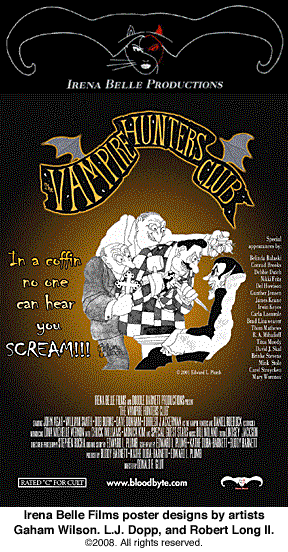
Photo credits for this webpage belong to Don Allen, Leanna Chamish, Mark A. Lampert, and Robert Long II, respectively. ©2008 Irena Belle Films. All rights reserved. Used with permission.
